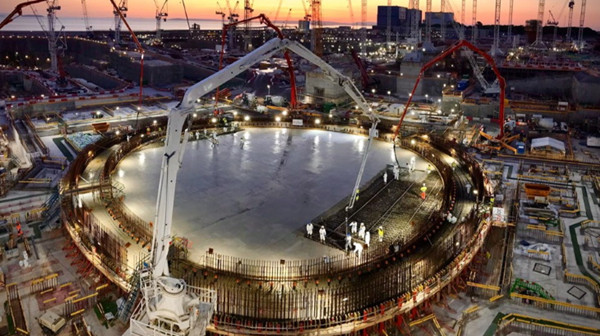Foundation completed for Hinkley Point C unit 2
Construction of the 49,000-tonne concrete basemat for the nuclear island of the second unit at Hinkley Point C has been completed. EDF Energy said the milestone had coincided with its ambition to spend GBP1.5 billion (USD1.9 billion) with regional businesses in South-West England five years ahead of target.

Concrete being poured for the final section of the foundation of the nuclear island for unit 2 of the Hinkley Point C plant (Image: EDF Energy)
The foundation of the nuclear island for unit 2 comprises 20,693 cubic metres of concrete. The final concrete pour of 8991 cubic metres set a new UK record for a single, continuous pour, EDF Energy announced today. It surpasses by 37 cubic metres the previous record set during construction of the base for the first unit in June 2019.
"This major milestone in nuclear construction was completed by teams who have had to adapt to new coronavirus working conditions," EDF Energy said. "Their achievement, known as 'J-zero', comes less than a year after the completion of the first reactor's base in June 2019." Referring to the completion of the installation of the first safety related pipework into Hinkley Point C unit 1 earlier this year, the company said, "It is the second major goal in 2020 and the successful completion of both follows the achievement of all the project goals in 2019." It noted that the date for achieving J-zero on unit 2 was set more than four years, before the final investment decision was taken.
Hinkley Point C Managing Director Stuart Crooks said: "On this unit we have demonstrated improvements in productivity. We can now install a tonne of steelwork in 16 hours, whereas on unit 1, it took 25 hours." EDF Energy said this improved productivity will benefit the proposed follow-on project at Sizewell C in Suffolk, the planning application for which was submitted last week..
Construction work was able to continue during the pandemic thanks to safety measures that included reducing numbers on site to enable social distancing. Where this is not possible, workers have been using extra protective equipment.
"I want to thank workers and our union partners for their extraordinary efforts to make safe working possible during the pandemic," Crooks said. "They have adapted to major changes in everyday behaviours and working practices which would have been unimaginable a few months ago. The commitment of our specialist suppliers across the UK and in Europe has also been instrumental in helping us safely achieve this major milestone. And we must never forget the duty of care we owe to our community, whose on-going support is vital to the success of our project."
Under a deal agreed in October 2015, China General Nuclear took a 33.5% stake in EDF Energy's project to construct Hinkley Point C. It will be the first new nuclear power station to be built in the UK in over 20 years and will provide about 7% of the country's electricity. The first of its two EPR reactors is scheduled to start up at the end of 2025.
Spending target exceeded
New figures issued last week also show that Hinkley Point C beat its ambition to spend GBP1.5 billion with regional businesses five years ahead of target. The project's latest socio-economic impact report shows that GBP1.7 billion has now been spent with more than 1100 companies across the region.
The target for spending in the South-West of England was set during the planning of the new nuclear power station in 2012 and was reached early thanks to a continued focus on using local suppliers. Hinkley Point C has worked with organisations like the Somerset Chamber of Commerce, SWMAS and the Local Enterprise Partnerships to help a large variety of local businesses into the supply chain. Firms range from catering and hospitality suppliers to steel fabrication, electrical engineering and logistics specialists.
According to the latest report, Somerset has benefitted from GBP368 million of the spending, while the Bristol area has seen GBP448 million. GBP147 million has been spent in Gloucestershire and GBP59 million in Devon. Spending across the UK is also increasing as construction progresses; for example, spending on contracts in the Midlands and across the North of England has reached almost GBP1.1 billion.
Tom Greatrex, chief executive of the UK Nuclear Industry Association, said HPC represents a big step towards net-zero emissions in the country and also shows that nuclear energy's "large-scale green growth opportunities are real, and there is more to come".
A programme to replace and build on the UK's current fleet of reactors would equate to tens of billions of pounds per year of value added to a net-zero economy in 2050, he said, and create hundreds of thousands of jobs.
"The government understands the integral role of nuclear to decarbonisation, but now is the time to turn that support into clarity and commitments on the specifics. Its new energy policy must determine the size of the ambition, and set out a funding mechanism which removes unnecessary costs.
"The nuclear industry will rise best to the challenge of a planned programme, which will bring down costs further still and create long-term highly skilled jobs across the country for future generations who want to make a lasting difference," Greatrex said.
Researched and written by World Nuclear News
- China Institute of Atomic Energy
- Nuclear Power Institute of China
- Southwestern Institute of Physics
- China Nuclear Power Operation Technology Corporation, Ltd.
- China Nuclear Power Engineering Co., Ltd.
- China Institute for Radiation Protection
- Beijing Research Institute of Uranium Geology (BRIUG)
- China Institute of Nuclear Industry Strategy (CINIS)
- China Nuclear Mining Science and Technology Corporation


